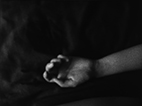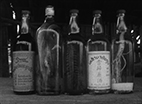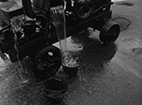Five Bad Elements, The
- Mark LaPore |
- 1997 |
- 32 minutes |
- B&W |
- OPT
Rental Format(s): 16mm film
NEW PRINT from Academy Film Archive - 2014!
A filmic Pandora's Box full of my version of "trouble" (death, loss, cultural imperialism) as well as the trouble with representation as incomplete understanding. - Mark LaPore
A dark and astringent film that allows the filmmaker's personal subconscious drives and the equivocal bad conscience of ethnography to bleed through into overt content. In several of his previous films (Depression in the Bay of Bengal and The Sudan Rolls) LaPore applied inspiration received from the early cinema of the Lumiere brothers allowing the integrity of the shot and the long take to convey a sense of continuing development. We witness discrete unfoldings of small narratives and performative processes of labor or unconscious movement that carry the tell tale symptoms of cultural transitions. There is also a heightened and uncanny sense of ordinariness (perhaps most strongly felt in LaPore's work in progress 100 Views of New York) seen with a tweaked awareness of instability and evanescence, the knowledge that the present has no permanent residence, the contemporary is in continuous eviction.
The serendipitous orchestration of the world composing itself in time within the domain of the fixed frame is set in a delicate equipoise with the sensibility and organizing vision of the filmmaker. With his exquisite observational acuity (visual, anthropological, sociological) and formal severity LaPore's approach aspires to a kind of rich transparency. Poetically decisive compositions open up the impedance in the flow and transference of the fabric of the real as it passes away into photochemical illusion. LaPore is expanding a tradition of experimental documentary filmmaking practiced by Calvacanti, Wright, Rouch, Gardener, the Macdougals, Hutton and Gehr, conducting profoundly cinematic, highly distilled personal investigations into the nature of cultural flux and reverie.
The hand held camerawork and the particular leverage of The Five Bad Elements both pushes and works against LaPore's previous tendencies in order to create compound fractures of potent abbreviations - seemingly dislocated images uncategorically taken and placed into 'improper' contexts, severed from a mappable space or geography - and overextended, unexpurgated scenes in which sight is caught actively probing or transfixed in seeming paralysis. By interrupting already truncated and mysteriously unmoored images with sections prolonging the durations and decay time of images normally torn from our sight, LaPore offers not provocation or obsession as much as permission to travel deeper into the image. The image as it pertains to actual experience - not only a filmic event or an approximate residue that stands in for something else as all images do. Refusing to satisfy curiosity with information, LaPore frustrates the usual complicities between image and documentary fact by dealing with representation as an execution of likeness, while still reckoning with the standard exchange rate of the image in its metaphoric fidelity to the real, the elusive and the tangible aspects of the image. LaPore's audacities are almost camouflaged by his refined sense of restraint, his austerity and lyrical contemplativeness.
The title of the film is mischievously cribbed from a gang of troublemakers that appears in Chinese filmmaker Xie Jin's film Hibiscus Town but also hints at the biblical concept of The Seven Deadly Sins, of universal ingredients - the four elements - earth, water, air and fire. Bad elements can refer euphemistically to a criminal milieu, "the wrong crowd," as well as suggesting the antiquated medical notion of the circulating "humors" that govern disposition and health. Going to the source of trouble was part of the filmmakers intent. LaPore: "I was more interested in who put those things into Pandora's box than I was in who let them out." In short the film is concerned with notions of basic and invasive influences, economy and eros, the rudiments of human composition, human error and the transgressive. Elements quietly attempts a suspect and perilous curative measure akin to bloodletting. "Key" evidence is spilled along with what would normally be suppressed or discounted as tangential. By exhibiting its own undercurrents and letting them hold sway, Elements thwarts commitment to documentary obligations which would prohibit its strangely moving and tainted disclosures. If we are used to works of transgression announcing themselves as such and then flamboyantly misbehaving as spectacular and bracing "entertainments," LaPore's move to a higher level of accomplishment could catch us off guard or seem oblique. Sound and image are subtly and rigorously counterpointed so as to fall into unnatural relations, blistering as they graze against each other and leaving a stinging afterglow of synesthesia and emotional voltage. By building the film on normally inadmissible evidence, telegraphed inferences, metaphoric leaps and omissions, damaged testimonies and scattered remains the film fabricates an impeccable and elegant architecture from a materially incomplete and unsound body. In the fragmented corpus of human beings and continents which is The Five Bad Elements, LaPore has created a film which itself acts as an absorbent object, a kind of metastatic sin eater that aims at expiation through its own contamination, redistributing poisons into a netherworld that still clearly resides at the core of its own physical and visible existence. -Mark McElhatten





